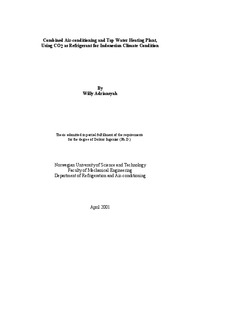| dc.contributor.author | Adriansyah, Willy | nb_NO |
| dc.date.accessioned | 2014-12-19T11:43:40Z | |
| dc.date.available | 2014-12-19T11:43:40Z | |
| dc.date.created | 2008-03-31 | nb_NO |
| dc.date.issued | 2001 | nb_NO |
| dc.identifier | 123925 | nb_NO |
| dc.identifier.isbn | 82-471-5316-5 | nb_NO |
| dc.identifier.uri | http://hdl.handle.net/11250/233361 | |
| dc.description.abstract | A combined air-conditioning and water heating system using carbon dioxide as refrigerant has been investigated theoretically and experimentally. A computer program simulates the combined system has been developed and verified with experimental data. Effects of the following parameters to the system performance were examined: ratio of hot water load to rejected heat from air-conditioning system (load ratio), evaporation temperature, cooling medium temperature, inlet water temperature, hot water temperature, discharge pressure, and presence of internal heat exchanger. Main results were coefficient of performance and cooling capacity.
It was concluded that there is an optimum pressure where the system reaches the highest coefficient of performance. Variation of coefficient of performance of the combined system with discharge pressures is similar to that of the airconditioning system without heat recovery.
Load ratio affects the performance of the air-conditioning side. Coefficient of performance of the air-conditioning side (cooling-COP) increased with increasing load ratio. Optimum discharge pressure was affected by load ratio.
Improvement of cooling-COP depends on both cooling medium and inlet water temperatures. The cooling-COP was lower at higher cooling medium temperature and higher inlet water temperature. When inlet water temperature is higher than cooling medium temperature, the cooling-COP will be lower compared to the airconditioning system without heat recovery.
The system performance decreased as hot water temperature increased. The decrease is due to a need for higher discharge temperature to achieve maximum cooling-COP.
Internal heat exchanger plays an important role in achieving higher system performance. Coefficient of performance is higher for the combined system with internal heat exchanger. The length of internal heat exchanger affects the cooling-COP and the location of the optimum discharge pressure.
Estimation results used for calculating annual energy consumption in various type of buildings show that the largest energy saving can be achieve in hospitals, followed by in hotels and in multifamily buildings. Simple comparison of combined CO2 system with separated R22 and stand-alone water heating system show better total system efficiency for CO2 system. | nb_NO |
| dc.language | eng | nb_NO |
| dc.publisher | Fakultet for ingeniørvitenskap og teknologi | nb_NO |
| dc.relation.ispartofseries | Dr. ingeniøravhandling, 0809-103X; 2001:54 | nb_NO |
| dc.title | Combined Air Conditioning and Tap Water Heating Plant, Using CO2 as Refrigerant for Indonesian Climate Condition | nb_NO |
| dc.type | Doctoral thesis | nb_NO |
| dc.contributor.department | Norges teknisk-naturvitenskapelige universitet, Fakultet for ingeniørvitenskap og teknologi, Institutt for energi- og prosessteknikk | nb_NO |
| dc.description.degree | dr.ing. | nb_NO |
| dc.description.degree | dr.ing. | en_GB |
